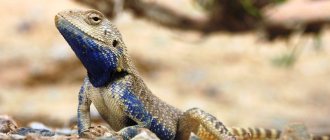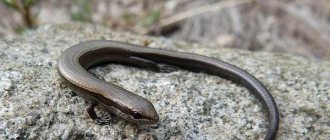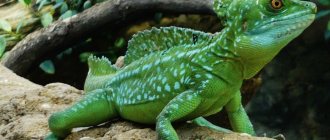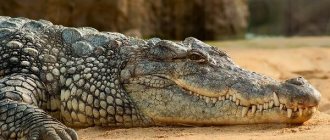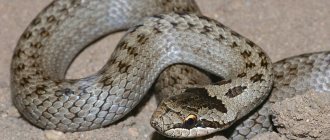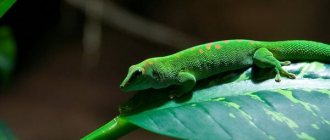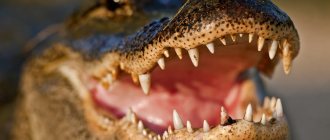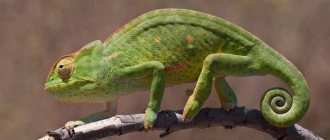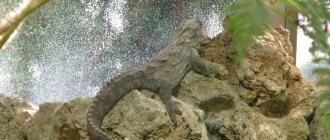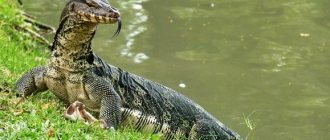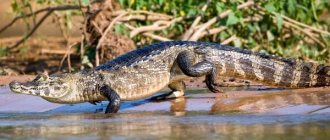The basilisk lizard cannot be confused with anyone else because of its ability to move funny and run on water. She is called Basilisk (Greek for “little king”) because of her resemblance to a monster resembling a rooster, snake and lion, which can turn a person to stone with a glance (Greek mythology).
These lizards can run through the water on their hind legs for 1.5 to 4.5 meters before settling on all fours to swim. Because of the way the basilisk runs through the water (the photo depicts this process), the reptile is called “Jesus Christ.”
General characteristics
The helmeted basilisk "Basiliscus plumifrons" is one of the most unusual lizards that can be kept in captivity.
Body length: 60 – 80 cm.
Life expectancy: 8 – 10 years.
Habitats
The habitat of the four existing species of basilisks is located in Central and South America. From Mexico to the coast of Ecuador. They live along rivers and other water basins, in places abundantly heated by the sun. Typical habitats are thickets of trees, dense reeds and other thickets of plants. When threatened, they jump from branches into the water.
Helmeted basilisks are very fast, they run superbly and can reach speeds of up to 12 km/h. And besides, in case of danger, they can dive under water.
External description
The color of the basilisk varies from bright green to brownish-olive. But offspring bred in captivity often have a bluish-green color. The belly of this lizard is yellow. Small white or blue spots can be seen along the back. And on the sides there are black stripes along the entire body, going to the tail. As the basilisk gets older, these spots and stripes may become more blurred or disappear altogether. This color allows them to remain unnoticed when they are hidden and sitting on the branches.
Like other types of basilisks, helmeted ones can run on the surface of the water for considerable distances (up to 400 meters) before plunging into it and swimming. For this feature they are even called “Jesus lizard” , alluding to Jesus who walked on water. They can also stay underwater for about 30 minutes to wait out danger.
Two thirds of the basilisk's body is its tail. The crest on the head serves to attract the attention of the female and for protection.
Reproduction
Lizards lay eggs in natural and domestic conditions. They reach sexual maturity at 2 years, after which they look for a family. Reproduction occurs regardless of the season; females lay 2–3 clutches per year, each containing 7–18 eggs. They remain pregnant for 2 months; during this period, males try to take better care of them. They then lay white eggs in the mucous membrane.
Females choose a place for laying in advance, so in a terrarium you should place a separate container up to 20 cm in height. A layer of sand and moss is laid out there to simulate natural conditions. The moss is kept moist, and immediately after laying the eggs are transferred to the incubator. Lizards hatch in 26–30 days if the air temperature is maintained at 30°C.
Reptiles do not have parental instinct, so you should not expect them to take care of their offspring. Young basilisks are immediately moved into a separate terrarium, since adult lizards eat them.
Maintenance and care
Terrarium
For keeping in captivity, you will need a fairly voluminous vertical terrarium: a terrarium with a volume of about 200 liters is required for one adult.
As a substrate, you can use clean (free from parasites and pesticides) soil, or a mixture of sand, peat moss and clean soil. At the same time, the substrate must be constantly moistened. In addition, the substrate must be cleaned once every two weeks. In case of severe contamination, change completely.
The daytime temperature in the terrarium is 28-30 ºC. Night temperatures can drop to 20-25 ºC. The temperature at the “warm-up point” can reach 35-38 ºC.
Humidity in the terrarium must be maintained at 70-90%. At the same time, at night, the humidity should be higher than during the day. In addition, during the tropical rainy season, it is recommended to spray the terrarium 3-4 times a day using a spray bottle.
To maintain humidity, installing a small waterfall would be an excellent solution.
Basilisks are quite active lizards; they definitely need a place closer to a heat source, where they can warm up after bathing. In addition, they love to move around the terrarium, where for this they need to place several thick driftwood that could support all the individuals living in the terrarium at once. It is also necessary to place shelters in case the lizards want to hide. As with other tropical lizards, live, non-poisonous plants with dense leaves can be placed in a basilisk terrarium.
Nutrition
The helmeted basilisk is a fairly omnivorous lizard. They should be offered mainly insects as live prey: grasshoppers, crickets, cockroaches, and zoophobass larvae. And, also - earthworms, mealworms, etc. Adults can be fed small mice and small, non-poisonous fish.
In the wild, basilisks consume flowers and leaves of tropical plants as plant food.
Breeding
Basilisks bred in captivity can be trained to eat plant foods that are not included in their diet in the wild. Such food includes sprouted wheat, as well as pieces of bananas, soft pears, oranges and other fruits, soft vegetables and berries.
The helmeted basilisk becomes sexually mature at the age of 1.5-2 years. Basilisks can breed all year round. The female's pregnancy lasts about two months.
The females need to be closely monitored and if they increase in size in the abdominal area, a container should be placed in the terrarium. It is recommended to choose a plastic container, about 20 cm high. At the bottom of the container you need to put a layer of sand, 2 cm thick, and a layer of moss, 6 cm thick. The substrate in the masonry container must always be moistened. As soon as the female has finished laying and weaned, she can be transferred to the incubator.
The incubation process is 26-31 days, at a constant temperature of 26-34 ° C.
The helmeted basilisk does not have the instinct to care for offspring, and therefore young individuals cannot be left in the terraum with adults, because they can be eaten by their parents.
Heating
Native to Central America, basilisks can nevertheless tolerate fairly cold temperatures, especially at night.
During the day, there should be a heating point in the terrarium, with a temperature of 32 degrees, and a cooler part, with a temperature of 24-25 degrees.
At night the temperature can be around 20 degrees. For heating, you can use a combination of lamps and other heating devices, such as heated stones.
Be sure to use two thermometers, one in a cool corner and one in a warm corner.
The Jesus Lizard is a basilisk that walks on water.
The helmeted basilisk is not just an excellent swimmer.
Eh, you people of little faith... Don’t believe? And the helmeted basilisk (Basiliscus basiliscus) can actually walk on water. For this ability, in many places this lizard is called Jesus lizard - Jesus lizard. Her walks on the water look very spectacular.
Both the fact itself and the speed of movement are striking. On the surface of the water, a basilisk can run up to 500 meters at a speed of 12 km/h. In addition, the animal is able to move rapidly on land (at a speed of up to 11 km/h - slightly slower than on water) and swims well. A basilisk can survive under water for up to half an hour. But of course, what is most striking is the lizard’s ability to walk on water. How is this possible?
Of course, there are insects that can walk on water. For example, water striders or water spiders. But their mass and dimensions cannot be compared with the basilisk. The weight of an adult lizard reaches 600 grams. Why does a basilisk walk on water and not drown?
To solve this mystery, scientists recorded the movements of the lizard in the clear water of the pool with a high-speed camera. When viewed in slow motion, it turned out that the basilisk still rows with its hind legs with huge claws rather than runs through the water. It is precisely due to the speed and force with which the lizard moves its paws that it stays on the surface of the water.
Feeding
Helmeted basilisks eat a variety of insects: crickets, zoophobus, mealworms, grasshoppers, cockroaches.
Some eat naked mice, but these should only be given occasionally. They also eat plant foods: cabbage, dandelions, lettuce and others.
They need to be cut first. Adult basilisks need to be fed plant foods 6-7 times a week, or insects 3-4 times. Young, twice a day and insects. The food should be sprinkled with reptile supplements containing calcium and vitamins.
Source
Jesus Lizard - Basilisk that walks on water: video
Eh, you people of little faith... Don’t believe? And the helmeted basilisk (Basiliscus basiliscus) can actually walk on water. For this ability, in many places this lizard is called Jesus lizard - Jesus lizard. Her walks on the water look very spectacular.
Both the fact itself and the speed of movement are striking. On the surface of the water, a basilisk can run up to 500 meters at a speed of 12 km/h. In addition, the animal is able to move rapidly on land (at a speed of up to 11 km/h - slightly slower than on water) and swims well. A basilisk can survive under water for up to half an hour. But of course, what is most striking is the lizard’s ability to walk on water. How is this possible?
Of course, there are insects that can walk on water. For example, water striders or water spiders. But their mass and dimensions cannot be compared with the basilisk. The weight of an adult lizard reaches 600 grams. Why does a basilisk walk on water and not drown?
To solve this mystery, scientists recorded the movements of the lizard in the clear water of the pool with a high-speed camera. When viewed in slow motion, it turned out that the basilisk still rows with its hind legs with huge claws rather than runs through the water. It is precisely due to the speed and force with which the lizard moves its paws that it stays on the surface of the water.
This is what it looks like:
Find out how a shrew that was thought extinct for 40 years was found in Africa.
Three waste stations and other reasons to choose eco-labeled products
Climbing Kilimanjaro: Africa's Greatest Adventure
Source
Description
The body length of an adult reptile is 60-80 cm, of which up to 50 cm is the tail. Body weight ranges from 250-500 g. The body is completely covered with small scales and has a bright green or bluish-green color. The tail has alternating yellow and brown stripes, and there are large light specks on the sides.
The head of the basilisk is decorated with a small skin outgrowth resembling a two-bladed helmet. The head itself is small, with a wide mouth. Eyes with bright orange irises are set on the sides of the head. Males have a high crest along the ridge. A low ridge also extends along the upper side of the long tail.
The short forelimbs are armed with long claws. The muscular hind limbs are much larger than the front ones. All five toes of the hind legs are equipped with scaly membranes.
How does a basilisk lizard run on water?
Did you know that basilisk lizards have an ability that would make any superhero jealous? They can walk on water. In this article we will talk about how they do this.
When you go on vacation, your destination is often somewhere near water. Whether it's a giant ocean, a raging river, a calm lake or just a swimming pool, there's nothing better than splashing around in the water.
What do we like to do in the water? Most often - diving, swimming, splashing and playing. But how many people think about walking on water? Unless you have supernatural powers, walking on water is definitely not on your to-do list.
If you are a basilisk lizard, then running on water may indeed be your daily activity. The green lizard, scientifically known as Basiliscus plumifrons, is also known as the Basilisk.
Its name comes from the unique crest on its head that males use to attract females. To some, the comb resembles a rooster's comb. This in turn led to comparisons to the mythical creature known as the Basilisk, which was half rooster and half lizard.
The green basilisk lizard also goes by another more common nickname: the Jesus Christ lizard. This nickname comes from the reptile's unique ability to walk on water.
Growing to approximately 60 centimeters in length (including tail), basilisk lizards are related to iguanas. They live in the tropical rain forests of Central America, found in abundance from southern Mexico to Panama. They like to spend most of their time in trees near a body of water. If a predator, such as a snake or bird, finds them in a tree, they can fall into the water and quickly run across the surface of the pond to safety.
Lighting
The terrarium needs to be illuminated using UV lamps 10-12 hours a day. The UV spectrum and daylength are critical for reptiles as they help them absorb calcium and produce vitamin D3.
If a lizard does not receive the required amount of UV rays, it may develop metabolic disorders.
Please note that the lamps must be changed according to the instructions, even if they do not fail. Moreover, these should be special lamps for reptiles, and not for fish or plants.
All reptiles should have a clear separation between day and night, so lights should be turned off at night.
Basilisk. Amazing facts about a lizard that can run on the surface of water
The basilisk lizard is known for its special ability to run across water.
Because of this amazing fact, the basilisk is also known as the Jesus Christ lizard. It belongs to the family Corytophanidae and is commonly found near rivers and streams in the tropical forests of North and South America.
How does the lizard of Jesus Christ run on the surface of the water?
Running on the surface of the water is an amazing ability of the basilisk lizard, which is also useful for humans. But this is only possible if you have some kind of supernatural power. However, the Jesus Christ lizard can do this very easily. These lizards mainly spend time near some body of water. To escape predators, they quickly jump into the water and gain enough speed to run across its surface a short distance to safety. This unique ability of the basilisk lizard is also useful when hunting prey such as insects.
Jesus Christ lizards have large feet with scaly fringes on the sides of the third, fourth and fifth toes. When the lizard walks on land, the scaly fringe is pressed against the toes. But if he senses some kind of danger or wants to hunt prey, he jumps into the water, spreading a scaly border on the surface of the water. This increases the surface area of the foot, allowing them to literally run on water for short distances.
The process of a basilisk running through water occurs in three stages. The first step is a spanking. The downward motion of the Jesus Christ lizard's foot pushes water out and away from the foot, which also creates air pockets around the foot. The second step is a kick, moving the leg back, pushing the animal forward. The third step is return. In this step, the foot rises and comes out of the water, ready to splash again.
Source
Habitats
Basilisks belong to the Corytophanaceae family. Previously, they were considered iguanas, but the discovered 9 species of lizards were recently separated into a family. In addition to them, there are 2 more representatives in the genus: caxo-headed and helmeted iguanas. Reptiles are found in tropical forests; scientists find them near the Caribbean Sea, in the forests of Honduras, near Costa Rica. Lizards live in lowlands and rarely settle above sea level, but such cases are also known.
Character
The helmet-nosed basilisk has a cautious character, it has many enemies in nature, so at the slightest danger it prefers to run away, because it has no way to resist the enemy, only its color can disguise it. Basilisks are good swimmers and can remain underwater for half an hour. On the ground, basilisks run quickly and can reach speeds of up to 11 km per hour. The basilisk can also run on water - thanks to the rapid movements of its hind legs, the basilisk can run up to 400 meters on the surface of the water at a speed of up to 12 km per hour.
Substrate
Various types of soil are acceptable: mulch, moss, reptile mixtures, rugs. The main requirement is that they retain moisture and do not rot, and are easy to clean. The soil layer is 5-7 cm, usually this is enough for plants and to maintain air humidity.
Sometimes, basilisks begin to eat the substrate, if you notice this, then replace it with something completely inedible. For example, a reptile mat or paper.
